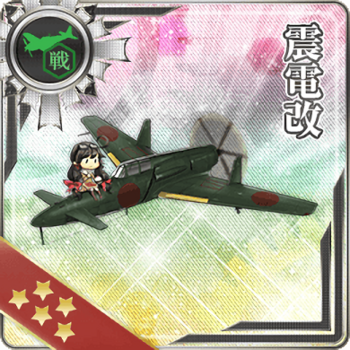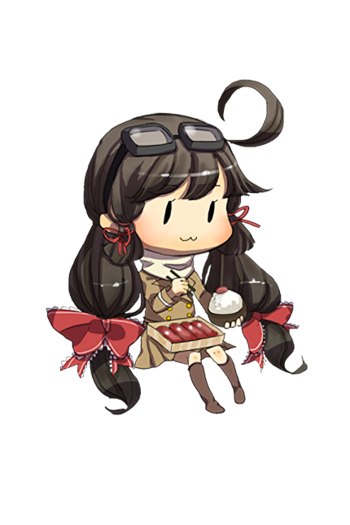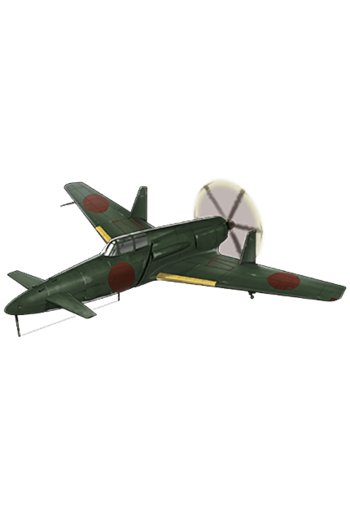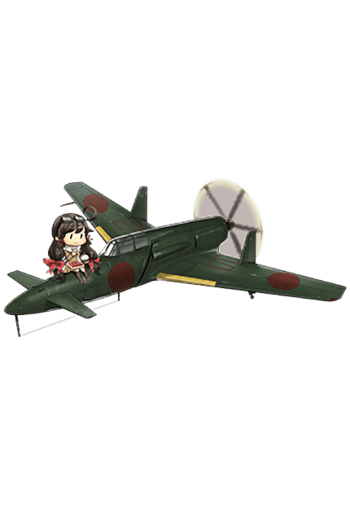- Welcome to the Kancolle Wiki!
- If you have any questions regarding site content, account registration, etc., please visit the KanColle Wiki Discord
Shinden Kai
[Edit]
Magnificent Lightning Kai
No.56 震電改
| |
| Refittable Ship Types | |
| Fast Battleship | Battleship |
| Aviation Battleship | Standard Aircraft Carrier |
| Armored Carrier | Light Carrier |
| Heavy Cruiser | Aviation Cruiser |
| Light Cruiser | Torpedo Cruiser |
| Training Cruiser | Destroyer |
| Coastal Defense Ship | Submarine |
| Aircraft Carrying Submarine | Seaplane Tender |
| Fleet Oiler | Submarine Tender |
| Repair Ship | Amphibious Assault Ship |
| LBAS Plane | |
Mechanics
Fighters![]()
![]() /
/![]() are one of the main types of plane used by CV(B/L). Their main role is to bring Air Power during the 1st Aerial Stage, with their "Fighter Power"
are one of the main types of plane used by CV(B/L). Their main role is to bring Air Power during the 1st Aerial Stage, with their "Fighter Power" ![]() stat being the most important factor in this regard. Fighters are additionally needed for Aircraft Carrier Cut-Ins (CVCI) during the day Shelling.
stat being the most important factor in this regard. Fighters are additionally needed for Aircraft Carrier Cut-Ins (CVCI) during the day Shelling.
- They can be used in Land Bases to serve the same role as Interceptors.
Notes
Not to be confused with the Shiden aircraft family.
How To Obtain
From limited-time quest: 2304 F1 (choice), 2401 B4 (choice)
Event reward for:
Updates History
- 2013-05-08: Added to game data and announced to be obtainable in the future
- 2013-05-17: Implemented
- 2019-03-22: Card CG updated
Trivia
- The depicted plane is allegedly the J7W2-A variant (did not exist/enter service as is).
- Historically, "Shinden Kai" actually refers to the J7W2, which was a proposed jet-powered variant of the Shinden that was never built even at the prototype level.
- Both the J7W1 Shinden prototypes and the planned J7W2 Shinden Kai were land-based aircraft. Kancolle's version is a theoretical variant with an arresting hook and reinforced airframe to facilitate carrier-based operations.
- Historical Information
Masayoshi Tsuruno, a lieutenant commander of the Imperial Japanese Navy technical staff, proposed a canard-based design in 1943. Masayoshi also believed the design could be easily retrofitted with a turbojet when the technology became readily available. His ideas were developed by the First Naval Air Technical Arsenal into three canard-based gliders designated the Yokosuka MXY6. A 22 hp Semi 11 engine was fitted to one of these gliders. All proved the feasibility of Masayoshi's proposal.
Impressed by the testing of the MXY6 units, the Navy ordered Kyushu Aircraft Company (formerly Watanabe Tekkoujo) to design an interceptor around Masayoshi's canard concept. Kyushu was relatively free to work on the idea unlike other manufacturers while Masayoshi was selected to lead a team from the First Naval Air Technical Arsenal to assist Kyushu's engineering team. The construction of two prototypes started in 1944 while stress calculations were completed in January 1945, producing a working prototype in April 1945.
The J7W1 prototype was by a 2,130 hp supercharged rear-mounted Mitsubishi MK9D (of similar lineage to what would be installed in the Reppuu) driving a six-bladed propeller via an extension shaft. The engine was cooled via long, narrow obliquely mounted intakes on each side of the fuselage, but this design caused problems when the engine was running on the ground. Unavailability of other components also postponed the flight of the J7W1. The prototype was flown successfully by Masayoshi in August 1945 but showed problems, such as vibration in the drive shaft.
A canard-based design means that a small wing or foreplane is placed ahead of the main wing of the aircraft, while the pusher configuration - a propeller located behind the engine - has unique advantages, such as not obstructing the placement of guns. Modern examples of canard aircraft include the successful Rafale and Typhoon multirole fighters.
Even before it had flown, the Navy ordered the J7W1 into production and it was to carry very heavy firepower of four 30 mm cannons. Regardless only the two prototypes were completed, with one scrapped while the other was claimed by the US Navy Technical Air Intelligence Unit. Subsequently, it was reassembled in the United States, before being transferred to the Smithsonian Institution and is now in storage at the National Air and Space Museum.
As a land-based interceptor that was never successfully produced, the Shinden Kai (in this case meaning "Modified" rather than "Improved") in Kancolle is a theoretical variant with modifications to operate in a carrier-based environment.



